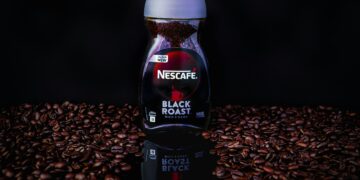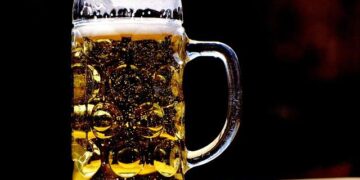Table of Contents
Part 1: The Seduction of the Can – My First Encounter with a High-Stakes Bargain
It started, as these things often do, under the fluorescent hum of a convenience store.
I was tired.
Not just end-of-a-long-day tired, but deep-in-my-bones weary.
My eyes scanned the wall of refrigerated doors, a kaleidoscope of energy drink options.
And then I saw it.
The Bang Energy can wasn’t just a beverage; it was a statement.
Its vibrant, almost radioactive colors and bold, futuristic font seemed to vibrate on the shelf.
The promises on the can were even more alluring.
It wasn’t just an energy drink; it was “potent brain & body-rocking fuel”.1
And the magic words that sealed the deal for a health-conscious person like me: “0 sugars, 0 carbs, 0 calories”.2
Here was a bargain that seemed too good to be true.
All the upside of energy without the dietary downside of the sugary concoctions I’d always avoided.
I chose a flavor—I think it was “Star Blast”—and felt a sense of virtuous self-optimization.
I was hacking my fatigue, the smart Way.
The first sip was a surprise.
It was intensely sweet, a flavor explosion that belied its zero-calorie promise.4
Then came the surge.
It was unlike any coffee buzz I’d ever known.
My thoughts sharpened, the world came into high definition, and the fatigue that had been clinging to me like a wet coat simply vanished.
For about an hour, I was a believer.
This wasn’t just marketing; this was performance in a can.
But every high-stakes bargain has a hidden cost.
The bill for my can of Bang came due about three hours later.
It wasn’t the gentle, sloping comedown of a cup of tea.
It was a cliff.
The clean energy was replaced by a frantic, buzzing anxiety.
My heart wasn’t just beating; it was thumping against my ribs, an erratic drumbeat of unease.6
My hands had a fine tremor, and my thoughts, once so clear, were now a chaotic swarm.
This wasn’t a crash back to tiredness; it was a plunge into a state of profound physiological distress that lasted for hours.7
Lying awake that night, heart still racing, I was haunted by a single, insistent question that became the genesis of this entire investigation: How could something marketed as “healthy fuel” make me feel so fundamentally unwell? What was really inside that can? I had been seduced by the promises on the label, but the truth, I realized, was written in the language of my own nervous system.
I had to find the answer.
Part 2: The Core Number – Deconstructing the 300 Milligram Reality
My investigation started with the most obvious question, the one printed right on the can, yet whose significance I had completely overlooked: How much caffeine? The answer was immediate, unambiguous, and staggering.
Every standard 16-ounce can of Bang Energy contains 300 milligrams (mg) of caffeine.2
At one point, it was even higher, at 357 mg, before being reformulated to the current level.6
To understand the sheer magnitude of this number, it’s helpful to think of your daily caffeine allowance as a financial budget.
The U.S. Food and Drug Administration (FDA) has cited 400 mg per day as an amount generally not associated with negative effects for most healthy adults.10
This 400 mg is your total daily budget.
A single can of Bang instantly spends 75% of that entire budget.
This leaves almost no room for anything else.
That morning cup of coffee (around 95 mg), a mid-day iced tea (around 47 mg), or a piece of dark chocolate—any of these common items would push you over the recommended limit and into a physiological deficit.12
For adolescents, the picture is far more alarming.
Medical organizations recommend that teens between the ages of 12 and 18 consume less than 100 mg of caffeine per day.14
A can of Bang contains
300% of this daily limit, a fact underscored by the warning printed on the can itself, which states it is “not recommended for individuals under the age of 18”.6
The number alone is powerful, but its context is what truly reveals the story.
Placing Bang in the broader landscape of caffeinated beverages shows it is not just another energy drink; it is an outlier, occupying the extreme end of the spectrum.
Table 1: The Caffeine Scorecard
| Beverage (Typical Serving Size) | Caffeine Content (mg) | % of Adult Daily Limit (400 mg) | % of Teen Daily Limit (100 mg) |
| Bang Energy Drink (16 oz) | 300 mg | 75% | 300% |
| Reign Energy Drink (16 oz) | 300 mg | 75% | 300% |
| Celsius Energy Drink (12 oz) | 200 mg | 50% | 200% |
| Monster Energy (16 oz) | 160 mg | 40% | 160% |
| Red Bull (8.4 oz) | 80 mg | 20% | 80% |
| Brewed Coffee (8 oz) | ~95 mg | ~24% | ~95% |
| Black Tea (8 oz) | ~47 mg | ~12% | ~47% |
| Cola (12 oz) | ~35 mg | ~9% | ~35% |
Data sourced from.6
This data reveals a critical point that goes beyond the numbers.
The problem isn’t just the amount of caffeine; it’s the delivery system.
A hot cup of coffee is typically sipped slowly, allowing the body to process the caffeine gradually.
A cold, sweet, 16-ounce beverage like Bang is designed for rapid consumption, often chugged in minutes before a workout or to fight off a wave of fatigue.12
This rapid intake floods the system, creating a much more intense and abrupt physiological shock than the same amount of caffeine consumed over a longer period.
The FDA itself warns that toxic effects, such as seizures, can be observed with the
rapid consumption of around 1,200 mg of caffeine.15
While a single can is a quarter of that dose, the principle of rapid, high-volume intake is what contributes significantly to its potent and often jarring effects.
The very nature of the product—its size, temperature, and palatability—is an integral part of its risk profile.
Part 3: Your Body on Bang – A High-Interest Loan on Your Nervous System
To understand why a 300 mg dose of Bang felt so different from three cups of coffee, I had to look deeper into how caffeine actually works.
This is where I had my first major epiphany.
Caffeine doesn’t create energy.
It’s a chemical impersonator.
In your brain, a neurotransmitter called adenosine builds up throughout the day, binding to receptors and signaling fatigue and sleepiness.9
Caffeine’s molecular structure is so similar to adenosine that it can fit into these same receptors, effectively blocking adenosine from doing its job.
This is the key mechanism: caffeine doesn’t give you new energy; it just prevents your brain from realizing how tired it already Is.17
This led me to a powerful analogy: consuming caffeine is like taking out a high-interest loan on your future energy. You get an immediate cash injection of alertness, but you haven’t actually earned it.
You’ve borrowed it.
And the interest on that loan is the inevitable crash, which is often far more debilitating than your original state of fatigue.
With a 300 mg dose from a can of Bang, you’re not just taking out a small loan; you’re taking out a payday loan at a predatory rate.
The Neurological Cascade
This adenosine-blocking action sets off a chain reaction in the brain.
With the natural “brakes” of adenosine disabled, other neurotransmitters like dopamine and norepinephrine are released more freely, leading to the desired effects of increased alertness, focus, and improved reaction time.16
In moderate doses, this can be beneficial.19
However, at the 300 mg level, the system is thrown into overdrive.
The body interprets this intense stimulation as a crisis and floods the system with stress hormones like adrenaline and cortisol, triggering a full-blown “fight-or-flight” response.17
This is the biological source of the negative effects I and so many others have experienced: severe anxiety, nervousness, irritability, and uncontrollable jitters.6
Forum discussions and news reports are filled with personal accounts mirroring my own, describing panic attacks, disorientation, and a feeling of being “cracked-out”.6
The loan comes with another punishing term: sleep disruption.
Caffeine has a long half-life, meaning it takes many hours for your body to eliminate it.
A 300 mg dose, even if consumed in the early afternoon, can wreak havoc on your sleep architecture hours later, preventing the deep, restorative stages of sleep necessary for physical and mental recovery.11
You might fall asleep, but the quality of that sleep is profoundly compromised.
The Cardiovascular Response
The fight-or-flight response has a direct and immediate impact on the cardiovascular system.
The surge of adrenaline can cause a rapid heart rate (tachycardia), heart palpitations, and a sudden spike in blood pressure.6
For a healthy person, this can be deeply unsettling.
For someone with a sensitivity to caffeine or a pre-existing or undiagnosed heart condition, it can be dangerous.
Reports from ER workers have noted cases where high-caffeine energy drinks like Bang were the suspected culprit in young, otherwise healthy individuals presenting with cardiovascular distress.12
In one tragic reported case, a user attributed a stroke they suffered after an intense workout to their consumption of Bang.6
This creates a vicious cycle.
You feel tired, so you drink a Bang.
The massive dose of caffeine disrupts your sleep, leaving you more exhausted the next day.
This heightened fatigue increases your perceived need for another high-potency stimulant to get through the day.23
The product becomes the “solution” to a problem it is actively creating and perpetuating.
You’re not just paying interest on the energy loan; you’re taking out a new, bigger loan each day just to cover the interest payments on the last one.
Part 4: Deconstructing the Formula – Science, “Broscience,” and Outright Deception
My investigation into the 300 mg of caffeine had explained the intense physiological reaction I experienced.
But it didn’t solve the whole mystery.
Bang wasn’t just marketed on its caffeine content; it was sold as a sophisticated, multi-ingredient “functional” beverage.
The can was a billboard of trendy wellness ingredients: “Super Creatine,” Essential Amino Acids (EAAs), and Coenzyme Q10 (CoQ10).2
To truly understand what was in the can, I had to scrutinize each of these claims.
What I uncovered was a story of legally-proven deception that fundamentally shattered the brand’s credibility.
The “Super Creatine” Deception
The cornerstone of Bang’s initial marketing and its primary point of differentiation was an ingredient called “Super Creatine”.24
This wasn’t just an additive; it was the brand’s identity.
Founder Jack Owoc made extraordinary claims about this proprietary compound, calling Bang a “miracle drink” and suggesting “Super Creatine” was “20 times more effective at reaching the brain than other forms of creatine” and could even help reverse conditions like Alzheimer’s and Parkinson’s Disease.24
These claims were so audacious that they drew the attention of rival Monster Beverage Corporation, which filed a massive lawsuit against Bang’s parent company, Vital Pharmaceuticals (VPX), for false advertising.26
The legal battle that ensued was not a simple corporate squabble; it was a public trial of the brand’s core scientific claims.
The verdict was a bombshell.
In 2022, a federal jury found that VPX and Jack Owoc had engaged in willful and deliberate false advertising.
The court determined that the “Super Creatine” claims were unsubstantiated and, most damningly, that the ingredient was not creatine at all.26
The jury awarded Monster a staggering
$293 million in damages, an amount that later grew with legal fees and is believed to be one of the largest awards in the history of the Lanham Act (federal trademark law).25
Bang was permanently enjoined from using the “Super Creatine” name or making its associated health claims.30
This legal outcome is the central reveal of the mystery.
It is a judicial confirmation of large-scale consumer deception.
The brand’s foundational promise was, according to the U.S. court system, a lie.
This fact doesn’t just discredit one ingredient; it casts a long, dark shadow of doubt over every other claim on the can.
The Supporting Cast: EAAs and CoQ10
With the brand’s credibility shattered by the “Super Creatine” verdict, a critical lens must be applied to its other “functional” ingredients.
The proven deception creates a logical “presumption of doubt.” A rational consumer can no longer take the company’s claims at face value.
- Essential Amino Acids (EAAs): The can prominently features “EAA Aminos”.2 EAAs are indeed the essential building blocks of protein that the body needs for muscle repair and growth.31 Their inclusion is meant to appeal to the fitness community. However, the critical question is one of dosage. Scientific studies demonstrating the benefits of EAA supplementation typically use specific, significant doses (often several grams) of carefully balanced amino acid profiles.32 Bang does not disclose the specific quantity of EAAs in its formula. Without this transparency, it is impossible to verify if the amount is sufficient to produce any meaningful physiological effect or if it’s a case of “label dressing”—including a minuscule amount of a trendy ingredient purely for marketing purposes. One study did find a small performance benefit from a caffeine and EAA combination, but this was in a highly specific and stressful environment (hot and hypoxic), and the effect was attributed to maintaining central drive, not building muscle.34
- Coenzyme Q10 (CoQ10): Also listed on the can, CoQ10 is a popular antioxidant supplement involved in cellular energy production.2 While some research suggests it may have benefits for heart health and energy, the evidence is mixed.36 The most significant issue with its inclusion in a beverage like Bang is its
poor bioavailability. CoQ10 is a fat-soluble compound, meaning it does not dissolve well in water and is not easily absorbed by the body from a water-based drink.39 Specialized formulation technologies are required to make CoQ10 water-soluble and bioavailable, and there is no indication that Bang utilizes such technology. Therefore, the actual amount of CoQ10 the body could absorb from a can of Bang is likely negligible and far from a therapeutic dose.
The pattern that emerges is clear.
The brand’s strategy appears to be leveraging the wellness halo of popular supplements.
The “Super Creatine” saga demonstrates a willingness to make unsubstantiated and ultimately false claims.
The inclusion of EAAs and CoQ10, without transparent dosing and in a formulation that raises serious questions about efficacy, follows a similar pattern of prioritizing marketing appeal over verifiable scientific benefit.
Part 5: The Company Behind the Can – A History of Controversy
A product is often a reflection of its creator.
To fully solve the mystery of what’s in a can of Bang, it’s essential to understand the “who” and “why” behind it.
The corporate history of Bang Energy is not a dry business footnote; it is a turbulent narrative of aggressive tactics, constant litigation, and ultimately, a stunning fall from grace that perfectly mirrors the product’s own reckless identity.
The story begins with founder Jack Owoc and his company, Vital Pharmaceuticals (VPX).41
From its inception, the brand’s ethos was one of aggressive disruption.
Fueled by a savvy social media presence and the outlandish health claims championed by Owoc, Bang experienced a meteoric rise, capturing a significant market share and becoming the third-highest-selling energy drink in the United States for a time.24
However, this hyper-aggressive strategy led to a constant state of conflict.
The company seemed to be in a perpetual legal war on multiple fronts:
- The Monster War: The primary conflict was with its chief rival, Monster Beverage Corp. This culminated in the two devastating legal losses: the $293 million false advertising verdict over “Super Creatine” and a separate $175 million penalty in a trademark infringement case.25
- The PepsiCo Feud: Bang entered into an exclusive distribution deal with PepsiCo in 2020, only for the relationship to sour dramatically. Owoc publicly accused PepsiCo of intentionally sabotaging the brand, leading to a messy and public split and further litigation.24
- Intellectual Property Lawsuits: The company was also successfully sued by Sony Music and the estate of the musician Prince for using their music in social media campaigns without authorization.24
The financial weight of these legal defeats, particularly the massive judgments won by Monster, became unsustainable.
In October 2022, Vital Pharmaceuticals filed for Chapter 11 bankruptcy protection.41
The final act of this corporate drama contains a twist of supreme irony.
In July 2023, the assets of Bang Energy were acquired out of bankruptcy for $362 million.
The buyer was none other than its arch-nemesis, Monster Beverage Corporation.44
The hunter had consumed its prey.
As part of the transition, Jack Owoc, the visionary and controversial figurehead who had built the empire, was terminated from the company he founded.24
This history is not separate from the product; it is the product’s origin story.
The corporate ethos of pushing boundaries, making extreme claims, and prioritizing marketing over established rules is perfectly encapsulated in the can itself.
The decision to load the drink with a caffeine level that pushes the very edge of the daily safe limit, combined with a flagship ingredient whose claims were legally proven to be a fabrication, is a direct reflection of the company’s reckless philosophy.
The can of Bang is the physical manifestation of the company that created it.
Part 6: The Verdict – A Calculated Risk, Not a Health Drink
My investigation began with a simple question born from a deeply unpleasant personal experience: What is really in a can of Bang Energy? The journey to find the answer led me through a labyrinth of caffeine science, courtroom documents, and a dramatic corporate history.
Now, with all the evidence gathered, the mystery is solved.
A can of Bang contains:
- A 300 mg dose of rapidly-delivered caffeine, an extreme amount that consumes 75% of an adult’s recommended daily limit in a single serving and is dangerously inappropriate for adolescents.
- A legacy of judicially-proven false advertising concerning its former flagship ingredient, “Super Creatine,” a deception that cost its original parent company hundreds of millions of dollars.
- A supporting cast of scientifically questionable ingredients like EAAs and CoQ10, whose inclusion seems driven more by marketing appeal than by verifiable physiological benefit, given the lack of transparent dosing and significant bioavailability challenges.
- The DNA of a company that prioritized hyper-aggressive growth and audacious claims over consumer trust, a path that led directly to bankruptcy and a hostile takeover by its greatest rival.
My final epiphany was this: Bang Energy is not a health drink.
It is not “fitness fuel.” It is not a “smart” choice for sustainable energy.
It is a high-potency stimulant product, and it must be viewed as such.
It belongs in the same category of consideration as a powerful pharmaceutical, not a refreshing beverage.
My initial feeling of being misled by the “zero sugar, zero calorie” health halo was correct.
That marketing was a clever facade, distracting from the high-stakes bargain contained within.
This realization doesn’t mean such products should be banned, but it demands that we, as consumers, become investigators.
We must arm ourselves with a new framework for evaluating not just Bang, but the entire ecosystem of “functional” products.
A Framework for Smarter Energy Choices
- Know Your Numbers, Know Yourself: Before you can evaluate a product, you must evaluate yourself. Understand the 400 mg daily guideline and conduct an honest audit of your total daily caffeine intake from all sources—coffee, tea, soda, chocolate, and medications. Be aware of your own sensitivity. The effects that are manageable for one person can be debilitating for another.
- Prioritize the Foundation: True, sustainable energy does not come from a can. It is built on the non-negotiable foundations of adequate sleep, proper nutrition, and consistent hydration. Supplements are, at best, a minor addition to a solid foundation, never a substitute for it. Using a high-potency stimulant to paper over a poor lifestyle is a recipe for burnout.
- Read Past the Hype: Become a skeptical reader of labels. Ignore the flashy claims on the front of the can and turn it around. Question the purpose and efficacy of every ingredient in a “functional” product. If a brand boasts about an ingredient but doesn’t disclose the precise dosage, assume it’s for marketing, not for effect.
- Choose the Right Tool for the Job: Understand the vast difference between a 95 mg cup of coffee and a 300 mg energy drink. One is a gentle nudge; the other is a physiological sledgehammer. If you choose to use a stimulant, use the right tool for the job and be fully aware of the price of borrowing that energy.
My journey started with naive trust and ended in critical understanding.
The goal of this report is to give you the tools to skip the painful middle step.
By looking beyond the buzz and understanding the full story, you can make an informed choice, not just about the can in your hand, but about how you choose to fuel your body and your life.
Works cited
- Not Enough Bang for Your Buck: Class Action Claims BANG Energy Drinks Are Deceptively Labeled, accessed August 6, 2025, https://www.classaction.org/news/not-enough-bang-for-your-buck-class-action-claims-bang-energy-drinks-are-deceptively-labeled
- Bang Energy® Sour Heads® Energy Drink, 16 fl oz – QFC, accessed August 6, 2025, https://www.qfc.com/p/bang-energy-sour-heads-energy-drink/0061076486343
- Bang® Cotton Candy Energy Drink, 16 fl oz – Gerbes Super Markets, accessed August 6, 2025, https://www.gerbes.com/p/bang-cotton-candy-energy-drink/0061076400031
- Is drinking a Bang energy every day bad??? :: Off Topic – Steam Community, accessed August 6, 2025, https://steamcommunity.com/discussions/forum/12/3177855357749545020/?l=brazilian&ctp=3
- Is drinking a Bang energy every day bad??? :: Off Topic – Steam Community, accessed August 6, 2025, https://steamcommunity.com/discussions/forum/12/3177855357749545020/?l=russian&ctp=3
- OUT WITH A BANG: RISING ADDICTION TO THE NEWEST …, accessed August 6, 2025, https://www.themuseatdreyfoos.com/top-stories/2020/02/24/out-with-a-bang-rising-addiction-to-the-newest-caffeinated-drink/
- Bang energy drink nearly killed me a work yesterday : r/nursing – Reddit, accessed August 6, 2025, https://www.reddit.com/r/nursing/comments/p9iv7i/bang_energy_drink_nearly_killed_me_a_work/
- dev2.pepsicopartners.com, accessed August 6, 2025, https://dev2.pepsicopartners.com/pepsico/en/USD/BEVERAGES/Energy-Drinks/Bang-Star-Blast/p/1-DF9IO-1
- How Much Caffeine in Bang Energy Drinks Compared to Others – CAFELY, accessed August 6, 2025, https://cafely.com/blogs/info/caffeine-in-bang-energy-drink
- www.fda.gov, accessed August 6, 2025, https://www.fda.gov/consumers/consumer-updates/spilling-beans-how-much-caffeine-too-much#:~:text=For%20most%20adults%2C%20the%20FDA,eliminate%20it%20from%20the%20body.
- Caffeine: How much is too much? – Mayo Clinic, accessed August 6, 2025, https://www.mayoclinic.org/healthy-lifestyle/nutrition-and-healthy-eating/in-depth/caffeine/art-20045678
- Bang energy drinks? Anything about them that should be avoided? : r/nutrition – Reddit, accessed August 6, 2025, https://www.reddit.com/r/nutrition/comments/u0ant4/bang_energy_drinks_anything_about_them_that/
- How much caffeine is too much? | MD Anderson Cancer Center, accessed August 6, 2025, https://www.mdanderson.org/cancerwise/how-much-caffeine-is-too-much.h00-159776445.html
- How Much Caffeine is Safe for You and Your Child – MedStar Health, accessed August 6, 2025, https://www.medstarhealth.org/blog/caffeine-energy-drinks-heart-safety
- Spilling the Beans: How Much Caffeine is Too Much? – FDA, accessed August 6, 2025, https://www.fda.gov/consumers/consumer-updates/spilling-beans-how-much-caffeine-too-much
- Caffeine: Cognitive and Physical Performance Enhancer or Psychoactive Drug? – PMC, accessed August 6, 2025, https://pmc.ncbi.nlm.nih.gov/articles/PMC4462044/
- Caffeine | Better Health Channel, accessed August 6, 2025, https://www.betterhealth.vic.gov.au/health/healthyliving/caffeine
- How does caffeine affect your brain health? | Endeavor Health, accessed August 6, 2025, https://www.endeavorhealth.org/articles/caffeine-brain-health
- Effects of coffee/caffeine on brain health and disease: What should I tell my patients?, accessed August 6, 2025, https://pubmed.ncbi.nlm.nih.gov/26677204/
- Is Your Caffeine Intake Negatively Impacting Your Mind and Body? – Henry Ford Health, accessed August 6, 2025, https://www.henryford.com/blog/2021/06/caffeine-intake-negatively-impacting-your-mind-and-body
- Stimulants – Alcohol and Drug Foundation, accessed August 6, 2025, https://adf.org.au/drug-facts/stimulants/
- Caffeine: How it impacts your health and wellbeing | UNC Health Appalachian | NC, accessed August 6, 2025, https://www.unchealthappalachian.org/blog/2023/caffeine-how-it-impacts-your-health-and-wellbeing/
- did anyone else quit drinking caffeine/energy drinks due to the potential risks – Reddit, accessed August 6, 2025, https://www.reddit.com/r/UCSD/comments/16xcpym/did_anyone_else_quit_drinking_caffeineenergy/
- Bang Energy Controversy, Explained – Sporked, accessed August 6, 2025, https://sporked.com/article/bang-energy-drink-controvery/
- Lawtrades Blog – How a $336m Fib Made a “Bang” in the Energy …, accessed August 6, 2025, https://www.lawtrades.com/blog-posts/how-a-336m-fib-made-a-bang-in-the-energy-drink-market
- Ninth Circuit Affirms Monster’s $311M Award Against VPX and …, accessed August 6, 2025, https://www.hueston.com/ninth-circuit-affirms-monsters-311m-award-against-vpx-and-former-ceo/
- Monster Energy Files False Advertising, Unfair Competition and Misappropriation Suit Against VPX – Hueston Hennigan, accessed August 6, 2025, https://www.hueston.com/monster-energy-files-false-advertising-unfair-competition-and-misappropriation-suit-against-vpx/
- Verdict: Vital Pharmaceuticals Must Pay Monster $293 Million – CSP Daily News, accessed August 6, 2025, https://www.cspdailynews.com/beverages/verdict-vital-pharmaceuticals-must-pay-monster-293-million
- Bang Energy False Advertising Lawsuit Settlement is $271M – The National Law Review, accessed August 6, 2025, https://natlawreview.com/article/false-advertising-large-jury-verdicts-2022-and-likely-uptick-false-advertising-suits
- A Cautionary Advertising Tale About Creatine and Energy Drinks – Holland & Knight, accessed August 6, 2025, https://www.hklaw.com/en/insights/publications/2023/06/a-cautionary-advertising-tale-about-creatine-and-energy-drinks
- Driven EAA – Full Spectrum Essential Amino Acid Drink, accessed August 6, 2025, https://www.drivennutrition.net/products/driven-eaa-full-spectrum-essential-amino-acid-drink
- High‐intensity interval training and essential amino acid supplementation: Effects on muscle characteristics and whole‐body protein turnover, accessed August 6, 2025, https://pmc.ncbi.nlm.nih.gov/articles/PMC7769174/
- Essential amino acid-enriched whey enhances post-exercise whole-body protein balance during energy deficit more than iso-nitrogenous whey or a mixed-macronutrient meal: a randomized, crossover study – PubMed Central, accessed August 6, 2025, https://pmc.ncbi.nlm.nih.gov/articles/PMC7791816/
- A Combination of Amino Acids and Caffeine Enhances Sprint Running Capacity in a Hot, Hypoxic Environment – ResearchGate, accessed August 6, 2025, https://www.researchgate.net/publication/280869588_A_Combination_of_Amino_Acids_and_Caffeine_Enhances_Sprint_Running_Capacity_in_a_Hot_Hypoxic_Environment
- A Combination of Amino Acids and Caffeine Enhances Sprint Running Capacity in a Hot, Hypoxic Environment – PubMed, accessed August 6, 2025, https://pubmed.ncbi.nlm.nih.gov/26248498/
- What Happens to Your Body When You Take CoQ10 Regularly – EatingWell, accessed August 6, 2025, https://www.eatingwell.com/health-benefits-of-coq10-11695492
- COENZYME Q10: Overview, Uses, Side Effects, Precautions, Interactions, Dosing and Reviews – WebMD, accessed August 6, 2025, https://www.webmd.com/vitamins/ai/ingredientmono-938/coenzyme-q10
- Coenzyme Q10 Supplements 101: Potential Benefits, Known Risks, and More, accessed August 6, 2025, https://www.everydayhealth.com/diet-nutrition/coenzyme-q10-supplements/guide/
- Coenzyme Q10 Metabolism: A Review of Unresolved Issues – MDPI, accessed August 6, 2025, https://www.mdpi.com/1422-0067/24/3/2585
- CZO.V: CoQ10 and Beta Glucan in Energy Drink – Zacks Small Cap Research, accessed August 6, 2025, https://scr.zacks.com/news/news-details/2017/CZOV-CoQ10-and-Beta-Glucan-in-Energy-Drink/default.aspx
- Bang Energy – Wikipedia, accessed August 6, 2025, https://en.wikipedia.org/wiki/Bang_Energy
- Case 0:19-cv-60809-RKA Document 429 Entered on FLSD Docket 08/03/2021 Page 1 of 128, accessed August 6, 2025, http://business.cch.com/ipld/VitalPharmaceuticalsMosterEnergy20210803128P.pdf
- Bang Energy parent company Vital Pharmaceuticals files for bankruptcy – Just Drinks, accessed August 6, 2025, https://www.just-drinks.com/news/bang-energy-parent-company-vital-pharmaceuticals-files-for-bankruptcy/
- Monster Beverage Completes Acquisition of Bang Energy, accessed August 6, 2025, https://investors.monsterbevcorp.com/news-releases/news-release-details/monster-beverage-completes-acquisition-bang-energy
- Where is Bang Energy Located? HQ & Global Offices (2025), accessed August 6, 2025, https://www.highperformr.ai/company/bangenergy
- Monster Beverage wins approval for Bang Energy acquisition | FoodBev Media, accessed August 6, 2025, https://www.foodbev.com/news/monster-beverage-wins-approval-for-bang-energy-acquisition
- Monsters, Celsius, Bangs — Oh My! – The Observer, accessed August 6, 2025, https://fordhamobserver.com/72224/recent/sports-and-health/monsters-celsius-bangs-oh-my/
- Bang vs. Reign: Let the Energy Drink Battle Begin – MELO Labs, Inc., accessed August 6, 2025, https://trymeloair.com/blogs/news/bang-vs-reign
- Bang vs. Monster Energy Drinks: Caffeine, Health Benefits & Risks | Corner Coffee Store, accessed August 6, 2025, https://cornercoffeestore.com/bang-vs-monster-energy-drinks/
- The Caffeine Content Of 34 Popular Energy Drinks, Ranked Lowest To Highest, accessed August 6, 2025, https://www.tastingtable.com/1316680/popular-energy-drinks-caffeine-content-amount-ranked/






